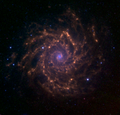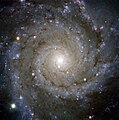astro.wikisort.org - Галактика
M 74 (Messier 74, Мессье 74, другое обозначение — NGC 628) — спиральная галактика в созвездии Рыб.
| M 74 | |
|---|---|
| Галактика | |
 | |
| История исследования | |
| Открыватель | Пьер Мешен |
| Дата открытия | 1780 |
| Обозначения | M 74, Messier 74, Мессье 74, NGC 628, UGC 1149, MCG 3-5-11, ZWG 460.14, IRAS01340+1532, PGC 5974 |
| Наблюдательные данные (Эпоха J2000.0) |
|
| Созвездие | Рыбы |
| Прямое восхождение | 01ч 36м 41,70с |
| Склонение | +15° 47′ 00″ |
| Видимые размеры | 10,5' × 9,5' |
| Видимая зв. величина | 9,1 |
| Фотографическая зв. величина | 9,8 |
| Характеристики | |
| Тип | Sc |
| Входит в | группа M74[d] |
| Лучевая скорость | 658 км/с[1] |
| z | +0,002188 ± 0,000007 |
| Расстояние | 35 000 000 св. лет[2] и 7,2 Мпк[3] |
| Угловое положение | 25° |
| Пов. яркость | 13,9 |
| Радиус | 47 500 св. лет[2] |
| Информация в базах данных | |
| SIMBAD | M 74 |
Описание
Предположительно в этой галактике обнаружена чёрная дыра промежуточной массы (то есть существенно больше звёздных масс, но меньше чёрных дыр в центре галактик) — уникальный ультрамощный квазипериодический рентгеновский источник[4].
В 2003 и 2013 годах замечены взрывы сверхновых SN 2003gd и SN 2013ej.
Галактика M74 входит в состав группы галактик M74. Помимо M74 в группу также входят ещё 18 галактик.
Галерея
См. также
- Список объектов Мессье
- Новый общий каталог
Примечания
- Tully R. B. Galaxy groups: a 2MASS catalog (англ.) // Astron. J. / J. G. III, E. Vishniac — NYC: IOP Publishing, American Astronomical Society, University of Chicago Press, AIP, 2015. — Vol. 149, Iss. 5. — P. 171. — ISSN 0004-6256; 1538-3881 — doi:10.1088/0004-6256/149/5/171 — arXiv:1503.03134
- Frommert H. Messier 74
- Cappellari M., Emsellem E., Krajnović D., McDermid R. M., Kleijn G. A. V., Scott N., Young L. M., Blitz L., Bois M., Bureau M. et al. The ATLAS3D project - I. A volume-limited sample of 260 nearby early-type galaxies: science goals and selection criteria (англ.) // Mon. Not. R. Astron. Soc. / D. Flower — OUP, 2011. — Vol. 413, Iss. 2. — P. 813–836. — ISSN 0035-8711; 1365-2966 — doi:10.1111/J.1365-2966.2010.18174.X — arXiv:1012.1551
- Ji-Feng Liu, Joel N. Bregman, Ed Lloyd-Davies, Jimmy Irwin, Catherine Espaillat, and Patrick Seitzer. A 2 Hour Quasi Period in an Ultraluminous X-Ray Source in NGC 628 (англ.) // The Astrophysical Journal. — IOP Publishing, 2005. — doi:10.1086/428902. — arXiv:astro-ph/0501306.
Литература
- Ben E. K. Sugerman. Discovery of a Light Echo from SN 2003gd (англ.) // The Astrophysical Journal. — IOP Publishing, 2005. — doi:10.1086/497578. — arXiv:astro-ph/0509009.
- M. I. Krauss, R. E. Kilgard, M. R. Garcia, T. P. Roberts, and A. H. Prestwich. M74 X-1 (CXOU J013651.1+154547): An Extremely Variable Ultraluminous X-Ray Source (англ.) // The Astrophysical Journal. — IOP Publishing, 2005. — doi:10.1086/431784. — arXiv:astro-ph/0505260.
- Bruce G. Elmegreen, Debra Meloy Elmegreen, Rupali Chandar, Brad Whitmore, and Michael Regan. Hierarchical Star Formation in the Spiral Galaxy NGC 628 (англ.) // The Astrophysical Journal. — IOP Publishing, 2006. — doi:10.1086/503797. — arXiv:astro-ph/0605523.
- Michael W. Regan, Michele D. Thornley, Stuart N. Vogel, Kartik Sheth, Bruce T. Draine, David J. Hollenbach, Martin Meyer, Daniel A. Dale, Charles W. Engelbracht, Robert C. Kennicutt, Lee Armus, Brent Buckalew, Daniela Calzetti, Karl D. Gordon, George Helou, Claus Leitherer, Sangeeta Malhotra, Eric Murphy, George H. Rieke, Marcia J. Rieke, and J. D. Smith. The Radial Distribution of the Interstellar Medium in Disk Galaxies: Evidence for Secular Evolution (англ.) // The Astrophysical Journal. — IOP Publishing, 2006. — doi:10.1086/505382.
- Kimberly A. Herrmann and Robin Ciardullo. Planetary Nebulae in Face-On Spiral Galaxies. II. Planetary Nebula Spectroscopy (англ.) // The Astrophysical Journal. — IOP Publishing, 2009. — doi:10.1088/0004-637X/703/1/894. — arXiv:0908.0531.
- Kimberly A. Herrmann and Robin Ciardullo. Planetary Nebulae in Face-On Spiral Galaxies. III. Planetary Nebula Kinematics and Disk Mass (англ.) // The Astrophysical Journal. — IOP Publishing, 2009. — doi:10.1088/0004-637X/705/2/1686. — arXiv:0910.0266.
- B. E. Warren, C. D. Wilson, F. P. Israel, S. Serjeant, G. J. Bendo, E. Brinks, D. L. Clements, J. A. Irwin, J. H. Knapen, J. Leech, H. E. Matthews, S. Mühle, A. M. J. Mortimer, G. Petitpas, E. Sinukoff, K. Spekkens, B. K. Tan, R. P. J. Tilanus, A. Usero, P. P. van der Werf, C. Vlahakis, T. Wiegert, and M. Zhu. The James Clerk Maxwell Telescope Nearby Galaxies Legacy Survey. II. Warm Molecular Gas and Star Formation in Three Field Spiral Galaxies (англ.) // The Astrophysical Journal. — IOP Publishing, 2010. — doi:10.1088/0004-637X/714/1/571. — arXiv:1003.1751.
- Stéphane Herbert-Fort, Dennis Zaritsky, Daniel Christlein, and Sheila J. Kannappan. The Surface Mass Density and Structure of the Outer Disk of NGC 628 (англ.) // The Astrophysical Journal. — IOP Publishing, 2010. — doi:10.1088/0004-637X/715/2/902. — arXiv:1003.4536.
- Hu Zou, Wei Zhang, Yanbin Yang, Xu Zhou, Zhaoji Jiang, Jun Ma, Zhenyu Wu, Jianghua Wu, Tianmeng Zhang, and Zhou Fan. Stellar Population Properties and Evolution Analysis of NGC 628 with Panchromatic Photometry (англ.) // The Astronomical Journal. — IOP Publishing, 2011. — doi:10.1088/0004-6256/142/1/16. — arXiv:1104.5177.
Ссылки
- Информация на английском и французском из оригинального «Нового общего каталога»
- Информация (англ.) из Пересмотренного «Нового общего каталога»
- VizieR (англ.)
- NASA/IPAC Extragalactic Database (англ.)
- Список публикаций, посвящённых NGC 628
На других языках
[de] Messier 74
Messier 74 (abgekürzt M74, auch als NGC 628 bezeichnet) ist eine Spiralgalaxie vom Hubble-Typ SA(s)c? im Sternbild Fische gut fünf Bogengrad nördlich der Ekliptik in der Nachbarschaft des Sterns Alpherg. Sie hat eine scheinbare Ausdehnung von 10,5′ × 9,5′ und eine scheinbare Helligkeit von +9,1 mag. Die Entfernung von M74 ist nicht genau bekannt, es werden Werte um 30 Millionen Lichtjahre genannt.[en] Messier 74
Messier 74 (also known as NGC 628 and Phantom Galaxy) is a large spiral galaxy in the equatorial constellation Pisces.[lower-alpha 1] It is about 32 million light-years away from Earth.[6] The galaxy contains two clearly defined spiral arms and is therefore used as an archetypal example of a grand design spiral galaxy.[7] The galaxy's low surface brightness makes it the most difficult Messier object for amateur astronomers to observe.[8][9] Its relatively large angular (that is, apparent) size and the galaxy's face-on orientation make it an ideal object for professional astronomers who want to study spiral arm structure and spiral density waves. It is estimated that M74 hosts about 100 billion stars.[6][es] Galaxia espiral M74
Messier 74 (también conocido como Galaxia del Abanico o NGC 628) es una galaxia espiral en la constelación de Piscis. Debido a su bajo brillo de superficie es considerada uno de los objetos más difíciles del Catálogo Messier, habiendo discrepancias entre astrónomos aficionados sobre su visibilidad con diferentes ópticas, y de hecho un catálogo estelar del siglo XIX, el Bonner Durchmusterung, llega a clasificarla cómo una estrella[5]- [ru] M 74
Текст в блоке "Читать" взят с сайта "Википедия" и доступен по лицензии Creative Commons Attribution-ShareAlike; в отдельных случаях могут действовать дополнительные условия.
Другой контент может иметь иную лицензию. Перед использованием материалов сайта WikiSort.org внимательно изучите правила лицензирования конкретных элементов наполнения сайта.
Другой контент может иметь иную лицензию. Перед использованием материалов сайта WikiSort.org внимательно изучите правила лицензирования конкретных элементов наполнения сайта.
2019-2025
WikiSort.org - проект по пересортировке и дополнению контента Википедии
WikiSort.org - проект по пересортировке и дополнению контента Википедии






